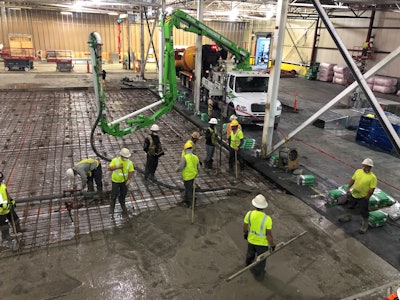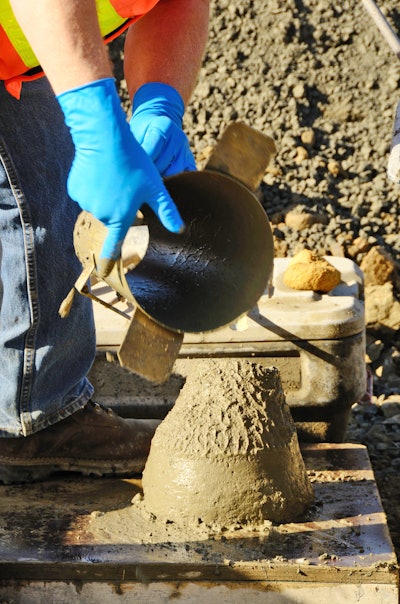Concrete is the canvas of the modern jobsite, especially when aesthetics matter just as much as performance. From stamped patios and colored walkways to polished floors and intricate overlays, decorative concrete continues to grow in popularity. But with beauty comes the demand for precision—and that’s where admixture technology makes all the difference.
Understanding how to leverage admixtures can mean the difference between a surface that cracks or curls and one that performs beautifully for years. These advanced chemical products help crews deliver consistent finishes, tackle tricky weather conditions and extend working time when it matters most—all while improving long-term durability and reducing maintenance.
Meeting the Challenges of Decorative Concrete
Water-reducing admixtures—such as plasticizers and superplasticizers—improve flow without adding water. That’s key when placing mixes in tight forms, around rebar or over radiant heat tubing. By lowering the water-to-cement ratio, contractors preserve strength while easing the placement and finishing process—even on jobs with detailed surface textures or aggressive placement schedules.
In hot weather or under the sun’s direct glare, concrete can set up faster than crews can finish. Set-retarding admixtures give finishers the time they need to stamp, texture or polish surfaces properly—without rushing the work or sacrificing quality. They’re particularly valuable for large pours or complex patterns where multiple passes are needed to achieve a seamless finish.
Viscosity-modifying admixtures are also gaining traction on decorative jobs. These admixtures help stabilize mixes, especially those with pigments or integral color, by minimizing segregation and ensuring consistent hue and texture across the slab. They also reduce bleeding and help prevent edge slump—which is especially important when dealing with thin, stamped sections or vertical surfaces.
Decorative overlays, skim coats and self-leveling toppings all depend on one thing: solid adhesion to the substrate. Without the right bond, these layers can delaminate or crack prematurely—often requiring costly rework, frustrating callbacks and potentially even reputational damage.
Polymer-modified admixtures are the go-to solution for strong bonding and flexibility. They improve adhesion to existing surfaces and reduce the brittleness often associated with thin-section concrete applications. Whether resurfacing a pool deck, applying a micro-topping or pouring a feather-edge finish, these admixtures help the decorative layer perform under both traffic and thermal movement.
Contractors applying stenciled or stained overlays also benefit from the enhanced surface compatibility offered by polymer admixtures. These materials help the overlay conform to surface contours and textures, ensuring crisp patterns and reliable stain absorption.
Achieving Durability for Tougher, Longer-Lasting Surfaces
Durability is a must—even in purely aesthetic applications. Outdoor concrete, in particular, has to stand up to freeze-thaw cycles, deicing salts, UV exposure and moisture infiltration. Many of these elements can degrade performance over time—unless properly addressed with the right admixtures.
Air-entraining admixtures are the frontline defense against freeze-thaw damage that can occur with decorative concrete. By introducing microscopic air pockets into the mix, they give expanding water room to move without fracturing the slab. These admixtures are essential for decorative flatwork in colder climates, particularly where deicers are frequently used.
Shrinkage-reducing admixtures minimize internal stress during curing, reducing hairline cracking and surface crazing. This helps decorative concrete surfaces maintain their appearance longer and prevents aesthetic defects that might emerge weeks or months after placement.
Need to accelerate the schedule? Accelerating admixtures promote early strength development and reduce set time, allowing for earlier finishing and form removal. This can be especially useful for fast-track commercial work or when rain is in the forecast and schedules are tight.
 The Euclid Chemical Company
The Euclid Chemical Company
Admixtures also play a big role in maintaining color integrity. Admixtures that distribute pigment evenly prevent mottling or streaking in integrally colored concrete, while efflorescence-control additives limit the migration of salts to the surface that can discolor or dull stained finishes.
When high-end results are required—such as polished floors or countertops—adding pozzolanic admixtures like silica fume or metakaolin enhances surface density, smoothness and visual uniformity. These materials refine the concrete matrix and improve stainability, polishability and wear resistance.
Designing the Right Mix with the Right Team
 Contractors should make sure to conduct trial batches to evaluate slump retention, among other factors that admixtures can affect. Prompt testing can give an opportunity to adjust and handle issues before they become costly.The Euclid Chemical Company
Contractors should make sure to conduct trial batches to evaluate slump retention, among other factors that admixtures can affect. Prompt testing can give an opportunity to adjust and handle issues before they become costly.The Euclid Chemical Company
Choosing the right cement type, aggregate gradation and pigment requires a system-wide approach. For example, high-range water reducers can significantly alter slump and setting behavior if they are not properly balanced. That’s why lab testing and trial batches are essential—especially for decorative concrete projects that involve tight tolerances or complex designs.
Trial batches allow contractors to evaluate slump retention, air content, color dispersion and finishability under controlled conditions. Adjustments can then be made before the concrete mix reaches the field, which ultimately saves time and avoids surprises.
Jobsite field trials are equally important. Real-world variables—like wind, ambient temperature, subgrade conditions and finishing practices—can influence final results. A concrete mix that looks great in the lab may need fine-tuning once placed at scale.
Admixtures also help concrete adapt to seasonal challenges. Retarders slow hydration in hot weather to extend workability, while accelerators promote set and strength gain in cold temperatures. These changes help ensure consistent results, no matter the season or site conditions.
A Smart Investment in Longevity & Sustainability
Some contractors hesitate to use admixtures due to perceived upfront costs. But when viewed over the lifecycle of the concrete, admixtures prove to be a smart investment. They help reduce labor time, prevent defects and extend service life—saving money over the long haul.
Shrinkage control admixtures eliminate cracks that might otherwise require expensive patching or sealing, while air-entraining admixtures protect against scaling and spalling in freeze-thaw environments. High-performance water reducers can even reduce the amount of cement needed, improving environmental efficiency and cutting material costs.
Admixtures also support green building goals. Water reducers optimize mix efficiency, lowering cement usage and carbon emissions. Supplementary cementitious materials like fly ash, slag and natural pozzolans repurpose industrial byproducts while enhancing durability.
Evolving to meet stricter environmental standards, many admixtures now contain recycled content and support LEED or similar certifications. By using these solutions, contractors can deliver decorative concrete that’s not only beautiful and durable—but aligned with sustainable construction practices.
Decorative concrete isn’t just about good looks—it’s about performance, precision and value. As clients demand more sophisticated finishes and tighter schedules, contractors need materials that help them execute cleanly and consistently. That’s why admixtures are becoming a must-have on decorative jobs.
By working with experienced suppliers and keeping up with advancements in admixture technology, contractors can differentiate their work, reduce callbacks, and build a reputation for excellence in both function and finish. Whether you’re resurfacing a driveway or installing an architectural feature wall, admixtures offer the flexibility and control needed to take decorative concrete to the next level.
View the original article and our Inspiration here


Leave a Reply